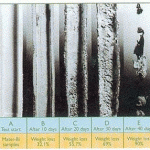Biodegradability
 When natural organic materials go into the ground, they tend to decompose progressively before they disappear.
When natural organic materials go into the ground, they tend to decompose progressively before they disappear.
This is very important for the environment, which has to get rid of waste to make room for new life. Photosynthetic organisms like trees, plants and algae, absorb carbon dioxide from the atmosphere. With the power of the sun, the inexhaustible source of energy, they use it to synthesise sugars and a whole range of other substances present in nature.
The flow of substances and energy passes along the food chain from the plants to the herbivores, and from these, to carnivores.
This mechanism would become blocked if the reverse process did not exist, so, in natural equilibrium, the process of biodegradation is as important as that of photosynthesis. Micro-organisms play a leading part in biodegradation. Micro-organisms are present in every environment and fed by organic waste. Through micro-organsims, organic material is transformed back into carbon dioxide thereby completing the natural cycle.
Compostability
Composting is the transformation of organic waste into compost. A pile of organic waste is attractive to micro organisms that are normally present in the environment. If the water content is sufficiently high, the micro organisms start to consume the nutritional substances to produce carbon dioxide, water and heat (biodegradation).
At the end of the process, the organic waste is transformed into a substance called compost. In composting plants, this process is controlled and optimised in order to achieve a high conversion speed, control of the effluent, control of the quality of the final compost, etc.
Production of compost and its use in agriculture completes the environmental cycle. The organic material returns to its place of origin in the form of compost, a substance that maintains fertility, prevents erosion of the soil, reduces the washing away of inorganic fertilisers and blocks the onset of micro-organisms that are pathogenic to plants, just to mention some of the positive aspects found with the use of compost.
In Australia with its low carbon soils and susceptibility to drought the benefits of compost are particularly marked. Compost improves water retention, mitigates run off and erosion and increases the resistance of plants to pests and diseases. A 1% increase in soil carbon increases the water storage capability of a hectare of soil by 140,000 litres!
 To check if a product meets Internationally accepted standards of compostability look for the seedling logo.
To check if a product meets Internationally accepted standards of compostability look for the seedling logo.
The Australian Bioplastics Association (ABA) http://www.bioplastics.org.au/ has launched the seedling logo to identity clearly certified compostable plastics.
ABA co-operates with European Bioplastics www.european-bioplastics.org , BPI (USA) www.bpiworld.org/ and other like minded bodies.
To learn more about Compost Australia :
